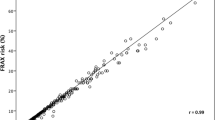Abstract
The objective of the study was to assess the impact of direct access DXA scanning (DADS) upon GPs' management decisions in patients considered to be at risk of osteoporosis. It was designed as a randomized, prospective, parallel group trial, set within the primary care environment and a university teaching hospital. The participants were 330 patients aged 31 to 89 years from 18 general practices in Edinburgh. Patients were randomized to either DADS or to the current system of specialist referral (controls). The primary outcome measure was frequency of change of management after DXA scanning. Secondary outcome measures were: change in health status, adherence to therapy, clinical events and resource use at one-year follow-up. The primary outcome was that 60% each of DADS patients (98/165) and controls (99/165) had changes in management following DXA scanning. In 30% of patients (12/41) in whom GPs had proposed changing management even in the absence of a scan, different therapy was chosen after the scan (no difference between DADS and control groups). There was an improvement in health utility (p =0.014 for both groups combined), differing slightly between the two groups even after age correction (p =0.014). 68% of the DADS group and 70% of controls were adherent to therapy after one year. In terms of clinical events, at one year there was one major adverse event (control group patient), 5 new fractures in the DADS group and 3 in controls - there were no hip fractures in this study. With regard to resource use, there were 24 referrals to hospital specialist after DXA scanning among the DADS group, vs 12 among controls (p < 0.05). The total number of visits to health professionals was 525 in DADS and 585 in controls (p=ns); mean waiting time from randomization to receipt of report/clinic letter was 4 weeks for DADS vs 13 weeks for controls(p < 0.0001). In conclusion, DXA scanning resulted in management change in at least 60% of cases. Direct access does not result in a clinical outcome significantly different from a consultant led service, and is more economically efficient than the current model of hospital referral.

Similar content being viewed by others
References
Consensus development conference (1991) Diagnosis, prophylaxis and treatment of osteoporosis. Am J Med 90:107–110
Cummings SR, Nevitt MC, Browner WS et al. (1995) Risk factors for hip fracture in white women: the study of osteoporotic fractures. N Engl J Med 332:767–773.
Report of a WHO Study Group(1994) Assessment of fracture risk and its application to screening for post-menopausal osteoporosis. Technical Report Series, 843, Section 3.2.3, p44. WHO, Geneva
Cummings SR, Black DM, Nevitt MC et al. (1993) Bone density at various sites for prediction of hip fractures. Lancet 341:72–75
Report of a WHO Study Group (1994) Assessment of fracture risk and its application to screening for post-menopausal osteoporosis. Technical Report Series 843. WHO, Geneva
Hansen MA et al. (1990) Dual energy X-ray absorptiometry: a precise method of measuring bone mineral density in the lumbar spine. J Nuc Med 31:1156–1162
Wilkin T, Davendra D, Dequeker J, Lutyen FP (2001) Education and Debate, for and against; bone densitometry is not a good predictor of hip fracture. Br Med J 323:795–799
Black DM, Thompson DE, Bower DC et al. (2000) Fracture risk reduction with alendronate in women with osteoporosis: the Fracture Intervention Trial, FIT Research Group. J Clin Endocrinol Metab 85:4118–4124
Harris ST, Watts NB, Genant HK et al. (1999) Effects of risedronate treatment on vertebral and non-vertebral fractures in women with post-menopausal osteoporosis: a randomized, controlled trial. Vertebral Efficacy with Risedronate Therapy (VERT) Study Group. JAMA 282:1344–1352
National Osteoporosis Society Scientific Advisory Committee (1995) Local provision for osteoporosis. Bath, England
Royal College of Physicians of London (1999) Osteoporosis — guidelines for prevention and treatment
National Osteoporosis Society (2000) Reducing fractures and osteoporosis in Scotland
Grimshaw JM and Russell IT (1993) Effect of clinical guidelines on medical practice: a systematic review of rigorous evaluations. Lancet 342:1317–1322
Brazier J, Jones N, Kind P (1993) Testing the validity of the Euroqol and comparing it with the SF-36 health survey questionnaire. Quality of Life Research 2:169–180
Altman DG (1991) Practical Statistics for Medical Research, pp. 455-457. Chapman and Hall, London
Department of Health Advisory Group on Osteoporosis (1995) AGO Report
Carstairs V, Morris R (1991) Deprivation and Health in Scotland. University Press, Aberdeen
Eastell R and Peel NFA (1994) Interpretation of bone density results. Osteopor Rev 2:1–4
Seeman E (1993) Osteoporosis in men: epidemiology, pathophysiology, and treatment possibilities. Consensus development conference on osteoporosis. Am J Med 95(5A):22–28
Acknowledgements
We thank all GPs and patients who participated in this study. We are grateful to Ms C Millar and Mr C Sidey for acquiring and analyzing the DXA scans, and Mr CM Ferrington for writing the Access database. We thank the following for their contributions to early discussions of the study proposal: Dr CM Lambert, Dr PL Padfield, Dr DP Wilks. Funding: Lothian University NHS Endowment Fund and Merck, Sharp and Dohme. Competing interests: none
Author information
Authors and Affiliations
Corresponding author
Rights and permissions
About this article
Cite this article
Dhillon, V., Creiger, J., Hannan, J. et al. The effect of DXA scanning on clinical decision making by general practitioners: a randomized, prospective trial of direct access versus referral to a hospital consultant. Osteoporos Int 14, 326–333 (2003). https://doi.org/10.1007/s00198-002-1371-2
Received:
Accepted:
Published:
Issue Date:
DOI: https://doi.org/10.1007/s00198-002-1371-2



